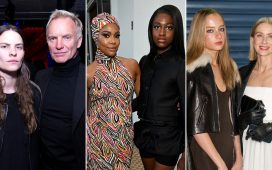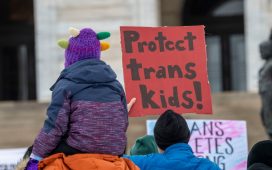Still, Kehlani’s never been a wilting gay flower in the music industry’s blazingly heteronormative sun. From the tongue-in-cheek, hypersexual camp of their 2016 track “Distraction” to their 2018 feature on the Kyle song “Playinwitme,” in which both Kyle and Kehlani playfully talk shit to, and vie for, a woman, Kehlani has knowingly smirked at the role they’re expected to play in popular music. Take their appearance on Hayley Kiyoko’s self-directed “What I Need” music video, in which the two gay icons play girlfriends. The video’s final conflict arrives when a man finds the pair secretly hitching a ride in the back of his pickup truck. He’s irate until he sees high femme Kehlani — gay, but in a way he can ignore — and proceeds to sexually harass them and ignore Kiyoko. Kehlani drives off with the man, leaving Kiyoko trudging heartbroken on the side of the road, until she sees Kehlani running to her in the distance. They collapse in each other’s arms, kissing between apologies and reassurances.
It’s a sweet, slightly schmaltzy video that, for a moment, touches on a long-standing tension in Kehlani’s music and career: how easily fluidity can become marketable in an industry hostile to nuance. In the past, artists like Madonna and Katy Perry have used sexual ambiguity to tease rebellion without fully alienating straight audiences or record execs. Meanwhile, out lesbians, like Melissa Etheridge or k.d. lang, could be pop stars as long as they weren’t too sexual and stuck to their folk and rock influences. By the time Kehlani’s career began, her femininity and queerness, which might have made her untouchable and unfathomable as an artist in decades past, was something the record industry could (and inevitably will) try to sell and celebrate for its authenticity. Her ability to appeal to queer pop/R&B fans of all genders while still offering a sexiness that’s palatable to straight men meant boundary-pushing superstardom could be in Kehlani’s cards.
But those cards seemed to reveal a different destiny the instant she blurted “I’m a lesbian” on Instagram Live. “I didn’t plan to come out in that way,” she says. “I was going to just let my new music speak for itself. All the music I’ve been making has been from this new perspective and this new clarity. That shit blew up and I didn’t expect it to when I said it — it just took its own life.”
For Kehlani, coming out to family and friends, then living a quietly queer life, was never a realistic possibility. Instead, for years, they have had to deal with countless media headlines and a mid-career moment of reckoning. “I was having full-blown identity issues [before]… [with] the balance of [my] masculinity and femininity. Especially being under the public eye,” she reflects. “The pressure to be sexy, and what does sexy look like and mean and feel like to me? How does that trail into my participation in the fashion world? What does that mean for photo shoots? What does that mean for everything? There’s this extra gigantic layer of things that I have to think about besides just waking up and being myself.”
Does coming out as a lesbian threaten to derail Kehlani’s potential for superstardom, even in the at least outwardly queer embracing music industry of the 2020s? Some homophobes lurking in the shadows think so. “I’ve seen some behind the scenes, not so nice text messages of like, ‘Oh, she’s a dyke now.’ Interesting energies,” Kehlani says. She adds that calls from other artists to collaborate haven’t stopped coming in, but have just gotten more attractive instead.
“It’s been actually cool to think about collabs in this new way where, if I’m doing a collaboration with a guy, I get to come from the same perspective as the guy singing it versus having to come in this typical duet form that’s like, you’re singing to me, I’m singing to you back,” she says. “It’s like, no, we talkin’ ‘bout the same girl!” she says with a laugh.








